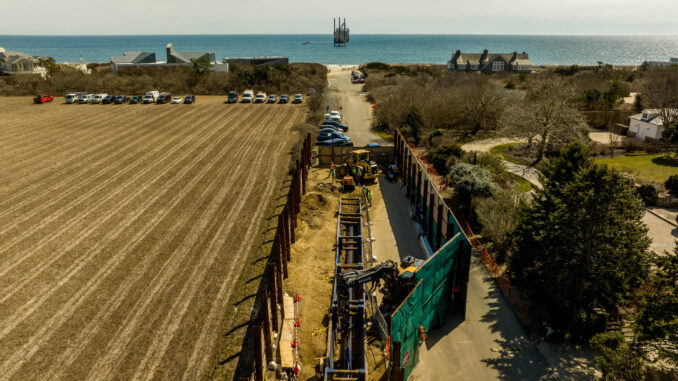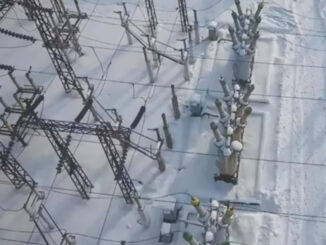
On May 23, EPA proposed a rule to reduce carbon dioxide emissions from most fossil fuel power plants. (The proposal and supporting documents total almost 700 pages.) Initially, EPA allowed only 60 days for public comment on the proposal. Despite requests from Members of Congress, grid operators and many others to extend the comment deadline by an additional 60 days, EPA extended the deadline by a mere 15 days. The final comment deadline was August 8.
Four of the largest grid operators – PJM Interconnection (PJM), Midcontinent Independent System Operator (MISO), Electric Reliability Council of Texas (ERCOT) , and the Southwest Power Pool (SPP) – submitted comments jointly and individually on the proposed rule. Each of these grid operators is responsible for maintaining the reliability of the power grid within their regions. Collectively, these four grid operators cover all or parts of 30 states (blue in the map below) and provide electric service to 154 million people, half of the U.S. population.

Their comments explain why the proposed rule poses major risks to grid reliability, despite EPA’s claims to the contrary . Below are 34 excerpts from their comments. The excerpts are taken from the “Joint Comments of Electric Reliability Council of Texas, Inc.; Midcontinent Independent System Operator, Inc; PJM Interconnection, L.L.C.; and Southwest Power Pool, Inc.” (“Joint Comments”) and from comments submitted individually by the same four grid operators. The excerpts address five topics: the threat to grid reliability, loss of reliability attributes, chilling effect on investment, technologies not being demonstrated, and the need for meaningful analysis.
1. THREAT TO GRID RELIABILITY
“… the Joint ISOs/RTOs are concerned that the Proposed Rule could result in material, adverse impacts to the reliability of the power grid.” Joint Comments
The proposed rule has “the potential to materially and adversely impact electric reliability. Moreover, the Proposed Rule, when combined with other EPA rules and other policy actions, could well exacerbate the disturbing trend and growing risk wherein the pace of retirements of generation with attributes needed to ensure grid reliability is rapidly exceeding the commercialization of new resources capable of providing those reliability attributes.” Joint Comments
“… the challenges and risks to grid reliability associated with a diminishing amount of dispatchable generating capacity could be severely exacerbated if the Proposed Rule is adopted.” Joint Comments
“… the Proposed Rule can have negative impacts on electric grid reliability even before the effective date [2030] of this rule.” Joint Comments
“The Joint ISOs/RTOs are concerned that the proposed rule would greatly exacerbate an ongoing loss of critical, dispatchable generating capacity that is needed to ensure grid reliability.” Joint Comments
“EPA’s Proposed Rule thus could, and likely will, undermine the mission of providing reliable power to the communities and consumers that MISO and others serve.” MISO Comments
“MISO also is concerned about impacts from the Proposed Rule on grid reliability and resource adequacy as MISO is experiencing a trending decline in reserve margin and fewer dispatchable ‘baseload” resources’ (i.e., currently in the form of coal and natural gas).” MISO Comments
“MISO’s comments focus on the fact that the Proposed Rule as currently written has the potential to trigger material negative impacts to grid reliability. Further, these material negative impacts will likely be amplified by the additive effects of other regulations that EPA has proposed and finalized in the past few years … MISO urges EPA to address grid reliability issues that would be caused by the Proposed Rule and exacerbated by other EPA air regulations. These actions to address reliability concerns should occur with the robust and thorough input of affected stakeholders and states as the Proposed Rule and the associated efforts to decarbonize the nation’s electric power sector are extraordinary and technically complex.” MISO Comments
“SPP is concerned that the Proposed Rule could exacerbate the already serious challenges posed by generator retirement, inadequate generation replacement, and increasing demand.” SPP Comments
“Robust grid reliability considerations need to be further built into the Proposed Rule, and subsequent regulations, which go beyond EPA’s past attempts to address grid reliability solely through limited workarounds like commitments to enforcement discretion or the scheduling of compliance dates.” Joint Comments
“SPP fears the Proposed Rule will continue the cumulative impact of other EPA actions that will make it difficult for fossil-fuel resources to maintain operational feasibility needed to meet SPP’s energy requirements.” SPP Comments
“If the technology and associated infrastructure fail to timely materialize, then the future supply of compliant generation—given forced retirements of non-compliant generation—would be far below what is needed to serve power demand, increasing the likelihood of significant power shortages.” Joint Comments
“If investors do not see fit to spend the likely substantial sums needed to construct compliant, dispatchable generation … due to concerns about the viability of the technology or the absence of the necessary pipeline infrastructure, or if the necessary transmission improvements are not built in a time frame to facilitate the delivery of the energy from the new resources, then the ERCOT region could be facing a significant increase in power outages along with an exponential increase in the average price of energy.” ERCOT Comments
2. LOSS OF RELIABILITY ATTRIBUTES
“The Joint ISOs/RTOs’ reliability duties extend beyond resource adequacy and include the provision of essential reliability services that are critical to the grid. Power-industry-defined reliability attributes include inertia, primary frequency response, reactive power support, system stability, system strength, frequency regulation, ramping, flexibility, dispatchability, black start capability, fuel and energy assurance, and extreme weather performance. The Joint ISOs/RTOs urge EPA to work with the Joint ISOs/RTOs in assessing the proposal’s impact on reliability, incorporating additional metrics around essential reliability services and attributes.” Joint Comments
“With continued and potentially accelerated retirements of dispatchable generation, supply of these reliability attributes will dwindle to concerning levels.” Joint Comments
“… new resources connecting to the grid are primarily inverter-based, and have distinctly different characteristics than synchronous machines. Although providing valuable carbon-free electricity, these new resources do not, at present, provide the same levels of essential reliability services – or attributes – as their thermal counterparts.” Joint Comments
“Meanwhile, baseload resources with high accreditation values and needed system attributes are being significantly impacted by regulations such as EPA’s Coal Combustion Residuals (CCR) rule.” MISO Comments
“Even with the recognized growth of alternative and renewable energy sources, MISO continues to be concerned about the risk of a looming shortfall of resources and attributes needed to ensure grid reliability in the region.” MISO Comments
3. CHILLING EFFECT ON INVESTMENT
“The Joint ISOs/RTOs are equally concerned that the Rule (and the cumulative effect of all of the recent electric industry-related EPA actions and rulemakings) could have a chilling effect in the near-term on the investment needed to maintain dispatchable generating units until these new technologies develop.” Joint Comments
“… the Joint ISOs/RTOs are also concerned about the chilling impact of the Proposed Rule on investment required to retain and maintain existing units that are needed to provide key attributes and grid services before the compliance date required by the rule. Unit owners may decide to retire units early rather than incur additional expense and risk. Alternatively, should the units remain operational, with the expectation of retirement at a future date certain, then unit owners may forgo required maintenance in the interim because of the lower return on the investment from doing so. The failure to properly maintain generating units can lead to a higher incidence of forced outages of these units, diminishing the dispatchable generation supply in the interim.” Joint Comments
“There is true concern regarding the chilling impact of the Proposed Rule (and the cumulative effect of all of the recent EPA rulemakings) on attracting investment to maintain existing units within the current fleet as well as planned or proposed resources. Furthermore, this chilling effect extends to investment in maintaining a reliable fuel supply chain. A reliable fuel supply is just as necessary as a reliable generation fleet.” Joint Comments
4. TECHNOLOGIES NOT DEMONSTRATED
“… we believe that the Proposed Rule’s Best System of Emissions Reduction (BSER) determination overstates the commercial viability of CCS and hydrogen co-firing today and ignores the cost and practicalities of developing new supporting infrastructure within the time frames projected. Without firm proof of the commercial and operational viability of these technologies, proceeding with these requirements could place the reliability of the electric grid in jeopardy. In short, hope is not an acceptable strategy.” Joint Comments
“Overall, the Proposed Rule gives inadequate consideration of the significant cost and difficulty of building out entirely new infrastructure to support either the delivery of hydrogen as a fuel at the levels called for or the sequestration of carbon at levels called for in the Rule.” Joint Comments
“SPP has concerns that these technologies [CCS and hydrogen co-firing] have not yet been adequately demonstrated at scale and will not be commercially available at the level needed by the EPA’s proposed compliance time frame.” SPP Comments
“ERCOT is concerned that the emissions standards proposed in the proposed rule are premised entirely on technologies that have not yet materialized and that have not yet been demonstrated to be physically or commercially viable. If these technologies do not develop on the timeline anticipated by EPA, existing generators that provide critical functions such as dispatchability and grid inertia will be forced to retire, and customers could face severe power shortages in future years.” ERCOT Comments
5. NEED FOR MEANINGFUL ANALYSIS
“The Joint ISOs/RTOs note that this short Comment Period and the lack of dialogue on these specific issues leading up to the Proposed Rule have made it difficult for the Joint ISOs/RTOs to undertake the full analysis of reliability impacts that a Rule of this magnitude should include. It is for this reason that the Joint ISOs/RTOs urge that the EPA refrain from adopting the Final Rule for a sufficient but finite time to allow for a more thorough exploration of the reliability impacts of the proposed Rule and its impact on investment decisions, and to discuss these conclusions with the ISOs/RTOs.” Joint Comments
“The Joint ISOs/RTOs believe that the record is insufficient for the EPA to conclude that the Proposed Rule will not adversely impact reliability. The EPA should therefore reconsider moving forward with the Proposed Rule in its present form.” Joint Comments
“EPA’s Resource Adequacy Analysis Technical Support Document does not address the range of reliability issues that the proposed Rule could trigger, but, rather by its own terms, is solely focused on resource adequacy. While EPA distances itself from potential impacts to the grid, EPA acknowledges that resource adequacy on its own is ‘not sufficient’ for determining grid reliability.” Joint Comments
EPA’s analysis “ignores the cumulative impact of the various EPA rules and their intertwined nature, leaving an incomplete picture of the impact of the GHG rule on unit retirement decisions and resource adequacy.” Joint Comments
“The Proposed Rule puts an additional 15 GW of coal at-risk in PJM, pushing at-risk generation to 29% of installed capacity.” Joint Comments
“EPA’s underlying assumptions for the Resource Adequacy Analysis are extremely dependent on modeling the Inflation Reduction Act (IRA) in the base case, which masks the impact of the Proposed Rule by assuming that the retirements have occurred independent of the Proposed Rule … This ignores the cumulative impact of the various EPA rules and their intertwined nature, leaving an incomplete picture of the impact of the Proposed Rule on unit retirement decisions and resource adequacy.”



